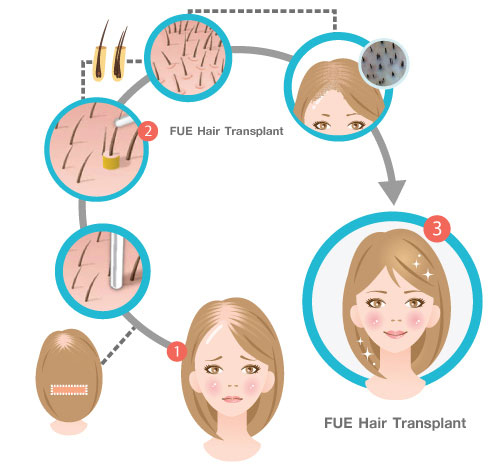Indications for transplantation are:
• focal, diffuse and androgenetic male pattern alopecia (female pattern baldness is not an obvious indication for transplantation and requires long-term specialist supervision).
• high anterior growth line, deep “bald patches”.
• hair loss due to various injuries, diseases, stress, external negative influences, lack of vitamins, and so on.
• congenital partial absence of hair.
• hereditary predisposition to baldness.
• genetically determined rare vegetation.
• aesthetic desire to increase the density of hair on the head, visually correct the shape of the forehead in the absence of a problem of hair loss.
• the need to cover scars with hair.
• thinning hair, as a result – loss of volume without loss.

FUE hair transplantation is the most advanced method of modern transplantation.
Compared to other scalp hair transplantation techniques, the FUE technique has a number of significant advantages, such as:
• the original length of the hair does not matter, no haircut is required.
• native hair is not damaged.
• no traces of interference in the donor area, its rapid healing.
• the procedure is minimally invasive.
• transplanted grafts contain 3-4 follicles at once, which increases the density of the hairline.
• absence of edema and pain syndrome, low probability of complications.
• maximum naturalness of transplanted hair.
• the result is saved for life.
Preparation for hair transplantation:

The doctor prescribes a series of tests to determine the exact cause of hair loss. The number of scheduled examinations and consultations for women is significantly higher than for men. This is due to the fact that long-term hair loss in women can be caused not only by androgenic alopecia (the most common cause of male pattern baldness), but also with a large number of other reasons for which hair transplantation does not help.
If, according to the results of the examination, there were no contraindications to transplantation, the date of the procedure is set (so that it does not coincide with menstruation).
The patient must adhere to a number of rules:
• refusal to stop baldness medicines (2 weeks before transplantation).
• a week before the appointed date, it is forbidden to take medicines that affect blood clotting.
• quitting smoking and drinking alcohol.
Hair Transplantation Process:
Local anesthesia is used to relieve pain during FUE surgery. At the first stage, donor material is taken. Unlike other techniques, FUE transplantation allows you not to cut the patient’s head. It is enough to shave a few thin stripes in the donor area, which can then be hidden by a hairstyle.
With the help of “punch”, the skin is removed from the back of the head along with a group of hair roots. Further, microscopic punctures / incisions that do not require suturing are made in the receiving zone, into which grafts are placed using tweezers. The length of the hair in the receiving area also does not matter, which eliminates the need to cut off native hair. The duration of the operation is 5-8 hours, the duration depends on the degree and size of the baldness area.
Rehabilitation Period:
After the procedure, physical and psychological rest is recommended. It is necessary to exclude contact of the transplanted hair with any surfaces. In the first days, the patient may experience a feeling of stiffness of the muscle tissue in the neck and itching. This is a normal reaction of the body, associated with the activation of the functions of transplanted hair follicles, tissue healing and normalization of lymph flow. These symptoms disappear completely after a few weeks.
Within 7-10 days after the procedure, it is necessary to completely exclude physical activity, smoking, drinking alcohol and prolonged exposure to the sun.
It is important to exclude aesthetic and cosmetological procedures of the head – styling, scrubs, peels, and so on. It is advisable to avoid wearing hats. It is not recommended to swim in the pool or the sea, steam in the bath or sauna.
Hair should not be washed for the first two days after surgery. The first shampooing should be done in the clinic. First, the hair follicles scab over and the patient has to go back to the hospital to have the scab removed.
This period is approximately 10 days and during this time the patient must wash her hair every day. Over time, the hair begins to grow and become stronger. Healthy and strong growth of all hair occurs between 8 and 12 months.

Benefits of choosing AstraMedicaGroup
Only top qualified doctors
JCI certificated hospitals
Free COVID-19 Test before departure
4 nights in a 5-star hotel in Istanbul
Costs for laboratory, medication and equipment
Pre/post-operative tests
Free Istanbul tours
Latest technologies
Excelent travel assistance
All-round VIP transfer
Credit / Debit cards accepted
No prepayment
Personal assistants speak in English
24/7 customer service
